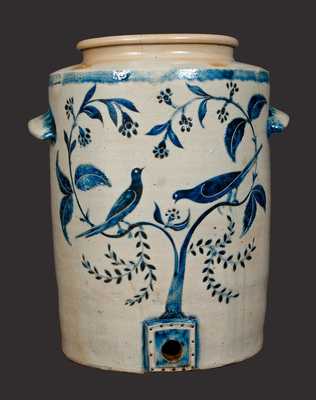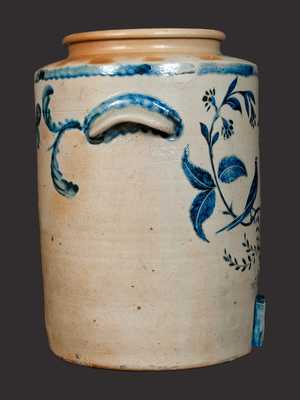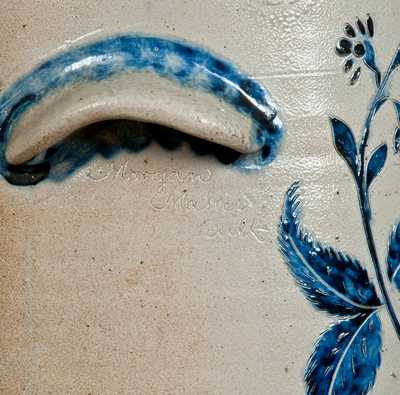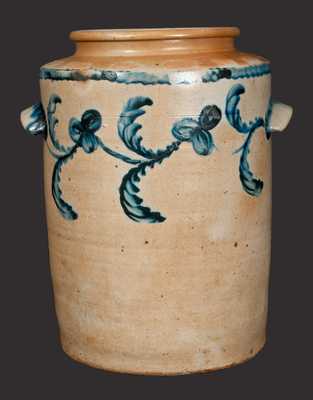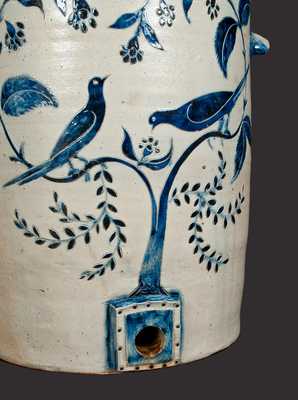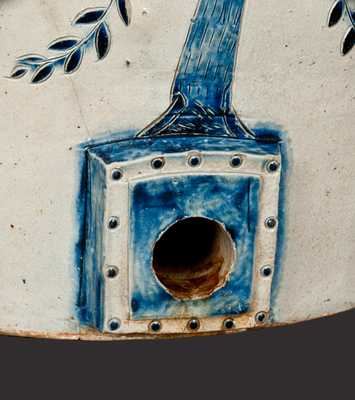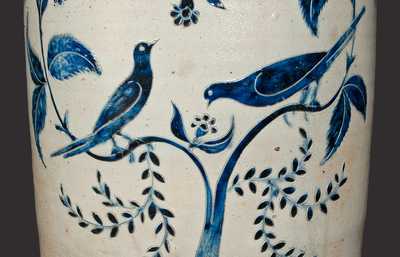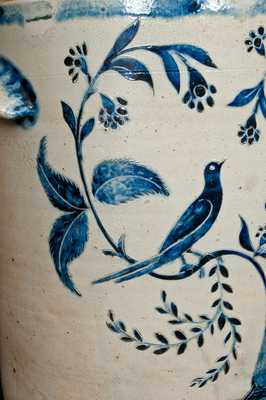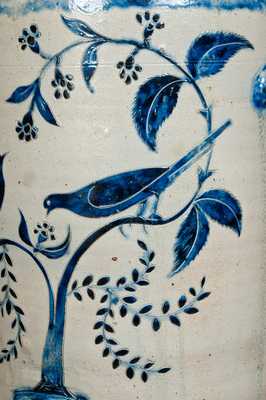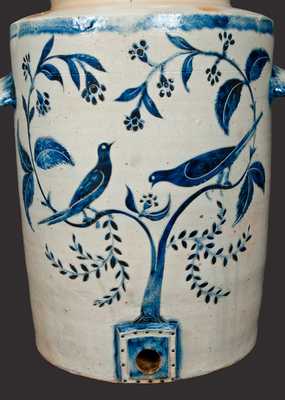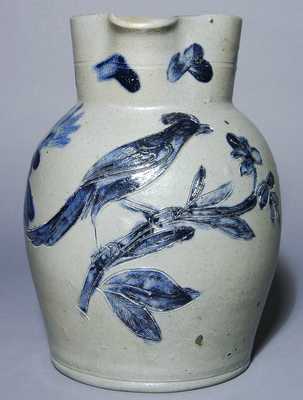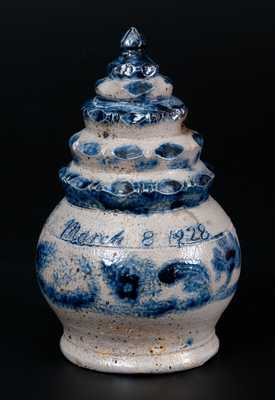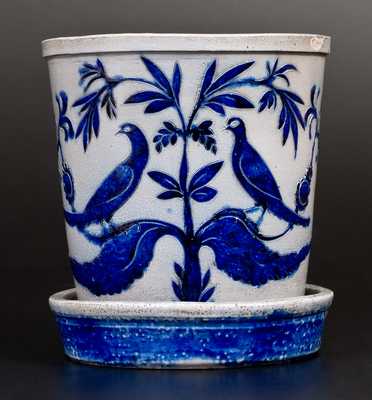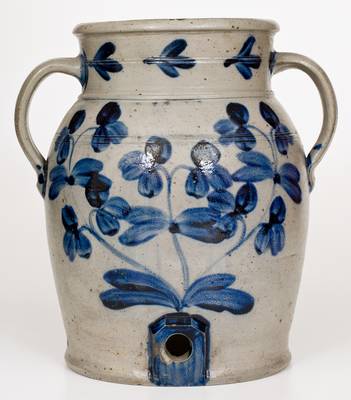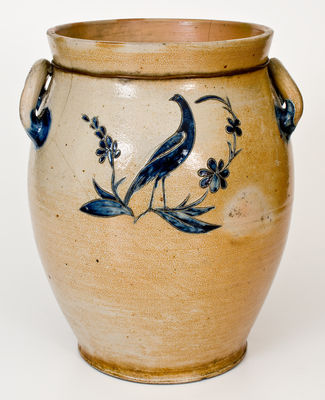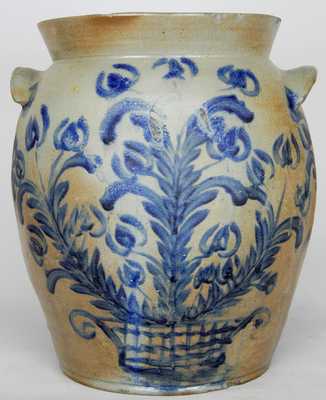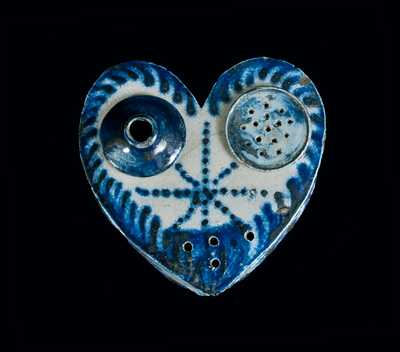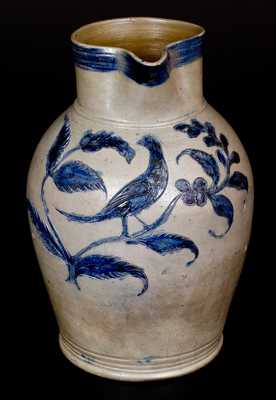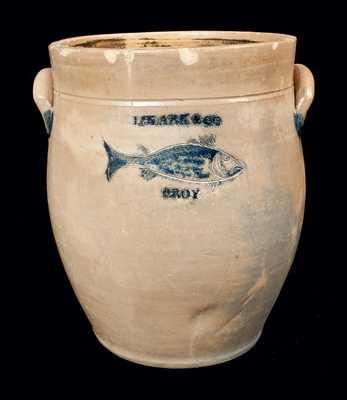Exceedingly Rare and Important Six-Gallon Stoneware Water Cooler with Profuse Incised Decoration of Birds Feeding in a Flowering Tree, Signed "Morgan Maker / Balt," William Morgan, Baltimore, MD, circa 1822-1827, cylindrical cooler with tapered shoulder, rounded rim, and large handles, the base with highly-unusual stepped bung hole, embellished with impressed circles and cobalt highlights. Front of cooler masterfully-decorated with a large and well-detailed incised design of two large birds perched in a flowering tree, which emanates from the cooler's bunghole. Tree includes scrolled branches, which form a heart around the birds, large leaves with serrated edges, and intricate vining at the base of the branches. The two birds, accented with nicely-incised feather detail and hollow eyes, are depicted feeding on the tree's flower blossoms in vertically-reaching and downward stances. The entire incised decoration is filled with bold cobalt slip, with delicate application throughout, particularly noticeable in the flower petals above the birds and leaves below. Cooler exhibits exceptional color and visually-stunning contrast with vivid cobalt set against a light-gray clay background. Circumference of shoulder decorated with a brushed cobalt band. Cobalt highlights surrounding the handles. Brushed flowering vine extending from handle-to-handle on reverse.
Arguably the finest surviving example of early Baltimore stoneware, this water cooler stands among the highest-quality stoneware produced in America during the period. Its pleasing form, pure gray clay body, and artfully-conceived-and-executed incised decoration, delicately filled with vibrant cobalt-oxide glaze, all combined to make this example a masterwork from the moment of its production.
This cooler's manufacturer, William Morgan, was a second-generation Baltimore stoneware potter, the son of Thomas Morgan, who brought stoneware manufacturing to the city. By 1818, William had taken over ownership of the shop alongside Thomas Amoss (a mostly-absentee partner after leaving for Henrico County, VA, the same year) and seems to have brought a new quality standard to the pottery. In 1822, William Morgan assumed sole ownership of the pottery after Thomas Amoss's death. While this shop's work has long been admired by collectors for its unusually-pure gray clay, a recent discovery has revealed that William Morgan was, in fact, aware that his clay source gave him a unique advantage among American stoneware manufacturers. On August 25, 1820, Morgan and Amoss advertised in part, "M & A have the satisfaction to inform their old customers as well as all others who purchase stone ware that they have lately purchased the exclusive privilege of two pits of fine clay, which upon trial has been found to make ware, which excels in beauty any thing of the kind now made, or perhaps ever was made in this country, out of which they intend to manufacture the most of their ware, as long as the pits will hold out."
While the Morgan pottery's clay supply indeed created a uniquely beautiful medium for this water cooler, its skillful decoration makes it one of the premiere surviving examples of stoneware from this period. Although most stoneware from this shop displays crisp slip-trailed decoration, this vessel exhibits an incised bird scene, which was clearly influenced by Manhattan-trained Henry Remmey, who arrived in Baltimore at the start of the War of 1812. A small group of surviving vessels with incised bird scenes manufactured by Remmey or his son Henry Harrison in Baltimore stand among the finest-known American stoneware of the period.
However, on this water cooler, William Morgan executed the Remmey-style incised bird decoration to perfection, rivaling and arguably exceeding the visual appeal of any known Remmey product. Utilizing the entire front of a six-gallon vessel (the largest of any incised Baltimore stoneware known), Morgan implemented a beautiful design, which he clearly planned to maximize the space on this water cooler. A forked tree trunk emanates directly from the stepped-and-ornamented spigot hole, with each fork curving to either side, ornamented similarly with vines, leaves, and hanging flowers. A bird perches on each fork. The entire decoration is carefully washed in cobalt-oxide with the glaze remaining within the crisp incising. Morgan cleverly left unglazed areas to maximize the visual appeal of this decoration, namely on the spigot hole, on the birds' wings, tail feathers, and eyes, and on the leaves' veins.
The quality of this water cooler clearly attests to a special purpose and surprisingly, with this example its initial purpose is well known. Created as an ice water fountain for Mrs. Robinson's hotel in Annapolis (now the well-known historic Maryland Inn on Church Circle), this water cooler served its purpose in the hotel for over six decades. The present owner's grandfather, Thomas Moors (born circa 1852), retrieved this water cooler when it was being discarded from The Maryland Inn (then The Maryland Hotel) while he was delivering milk to the establishment. Family history dictates that Moors had previously seen it serving iced water in the hotel's lobby and that he retrieved it circa 1888. However, it is possible that this water cooler was discarded concurrent with the hotel's public auction in 1890. The Maryland Inn is currently listed on Maryland Inventory of Historic Properties, described as "One of Annapolis's focal points visually and socially, as Inn was and is the meeting place for visitors and members of the Maryland General Assembly."
Provenance: Served as the ice water fountain in the lobby of the historical Maryland Inn in Annapolis for over sixty years. Acquired by the consignor's grandfather from the Maryland Inn circa 1888. Recently discovered in the consignor's home in Florida. Approximately 3" hairline from rim. 6" hairline on underside, continuing 5" up base of cooler to left of bunghole. (This hairline is difficult-to-see on the cooler's front, as the line is tight and mostly obscured by the cobalt on the left side of the bunghole.) Two very minor chips to inner edge of bunghole. H 17".

